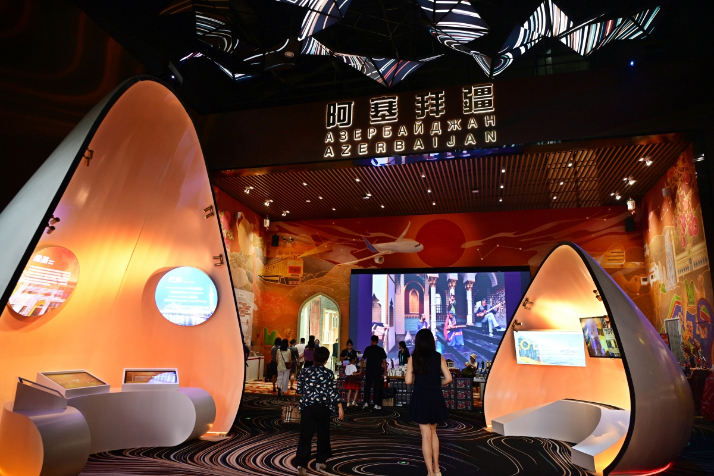The Summit That Could Shape the Future of Eurasia

The SCO Tianjin Summit 2025 will emphasize a key geopolitical trend of the 21st century. Regional groups that bridge political differences are critical spaces for dialogue and strategic positioning in a world marked by fragmentation.
Eurasian leaders will meet in China’s Tianjin from August 31 to September 1, for the 25th Meeting of the Council of Heads of State of the Shanghai Cooperation Organization (SCO). Known as the SCO Tianjin Summit 2025, the event takes place amid intense geopolitical tensions, shifting global power dynamics and a push to strengthen regional cooperation. Accounting for nearly 40 percent of the world’s population and over 20 percent of global GDP, the SCO has grown from a security-centric organization to a broad platform supporting economic collaboration, trade and sustainable growth.
The SCO was established in the early 2000s, driven by the need for security coordination, especially in combating the so-called “three evils”: terrorism, separatism and extremism. Over 20 years later, it has evolved into one of the few major multilateral forums, consisting of Belarus, China, India, Iran, Kazakhstan, Kyrgyzstan, Pakistan, Russia, Tajikistan and Uzbekistan. Its size, geographic scope and political diversity influence the organization significantly in global affairs.
For China, hosting the summit boosts its image as a key player in regional diplomacy and Eurasian integration. For Russia, it is a chance to show that it still has influential partners despite Western sanctions and its isolation from Euro-Atlantic institutions. For Central Asian member nations, the SCO provides a platform to balance relationships with major powers while advancing their development and security objectives.
The summit occurs amid broader ongoing tensions: the Russia-Ukraine conflict, Middle Eastern instability, Donald Trump’s re-imposition and expansion of tariffs, and escalating strategic rivalry between the U.S. and China.
While SCO summits produce lengthy communiqués and several side agreements, an analysis of the preliminary agreements reached in preparation for the summit suggests that the Tianjin meeting will focus on four primary areas.
Firstly, security and counterterrorism. Security cooperation remains central to the SCO. The Regional Anti-Terrorism Structure (RATS) based in Uzbekistan promotes intelligence exchange, joint training and counter-extremism efforts. There is a renewed emphasis on monitoring cross-border threats, especially after recent terrorist incidents in Pahalgam, India, and on the Jaffar Express in Pakistan, which have caused diplomatic tensions. While India and Pakistan differ on addressing such issues in the SCO documents, the upcoming summit may help find a compromise to present a united stance.
Secondly, economic cooperation and connectivity. China aims to deepen economic integration by linking SCO initiatives with the Belt and Road Initiative. Central Asia’s strategic position as a transit route between East Asia and Europe makes transport infrastructure, such as railways, roads and pipelines, a key focus. Russia and Iran want to expand north-south routes connecting the Indian Ocean with the Arctic. Plans include joint investment funds, industrial parks and possibly an SCO development bank.
Thirdly, currency diversification. Several SCO members are working to decrease dependence on the U.S. dollar for trade, opting instead for national currencies or regional payment systems. Although technical and political hurdles remain, this shift reflects geopolitical considerations and practical concerns about sanctions risks.

Lastly, sustainable development and the environment. Building on last year’s “Year of Ecology,” the 2025 theme emphasizes broader sustainable development, including renewable energy and disaster resilience. This aligns with Central Asia’s water security and climate change adaptation goals, alongside China’s desire to position itself as a leader in green development.
Despite increasing cooperation, the SCO remains susceptible to tension. Frequently, hostility between India and Pakistan influences the agenda, hampering document consensus. India remains wary of China’s strategic partnership with Pakistan and Beijing’s economic role in the region.
The Russia-Ukraine conflict might also pose a sensitive challenge.
While Russia can expect diplomatic neutrality from other SCO members, overt backing for Russia is improbable. India, in particular, aims to balance relations with Moscow and Western capitals. Additionally, Iran’s interactions with Gulf Arab states, some of which have stronger ties to China, could indirectly affect discussions on regional stability.
The tangible outcomes of SCO summits might appear limited, but their strategic significance can be substantial. Agreements to ease trade and improve transport links could transform Eurasian supply chains. Even small steps toward currency diversification could undermine the U.S. dollar’s dominance in bilateral trade. Furthermore, joint security exercises and intelligence sharing could enhance member states’ capabilities to address common threats independently.
The importance is equally notable on the external front: for Russia and Iran, proximity to Asia’s largest economies counterbalances Western isolation; for China, chairing a united summit enhances its reputation as a responsible regional leader.
The Tianjin summit will unlikely resolve all the SCO’s divisions or turn the organization into a fully unified bloc. However, it will emphasize a key geopolitical trend of the 21st century. Regional groups that bridge political differences are critical spaces for dialogue and strategic positioning in a world marked by fragmentation.
Even small breakthroughs, such as a joint counterterrorism statement easing India-Pakistan tensions or a new infrastructure financing plan, would be seen as steps toward greater Eurasian integration.
As leaders meet in Tianjin, the SCO’s main challenge will be transforming its demographic and geographic strength into genuine strategic influence, benefiting not only its members but also contributing to the stability and prosperity of the entire Eurasian region.
The author is former prime minister of Kyrgyzstan, a distinguished professor of the Belt and Road School at Beijing Normal University and author of the book Central Asia’s Economic Rebirth in the Shadow of the New Great Game.
 Facebook
Facebook
 Twitter
Twitter
 Linkedin
Linkedin
 Google +
Google +










